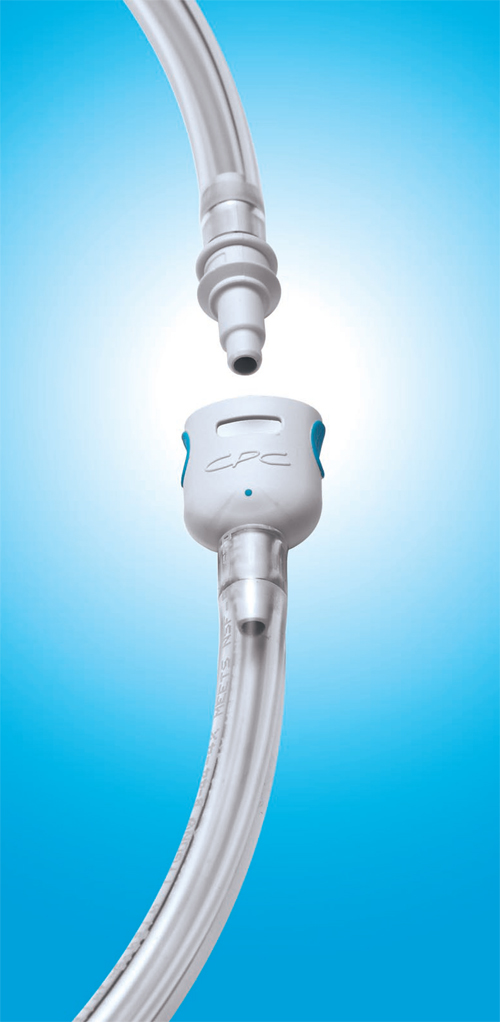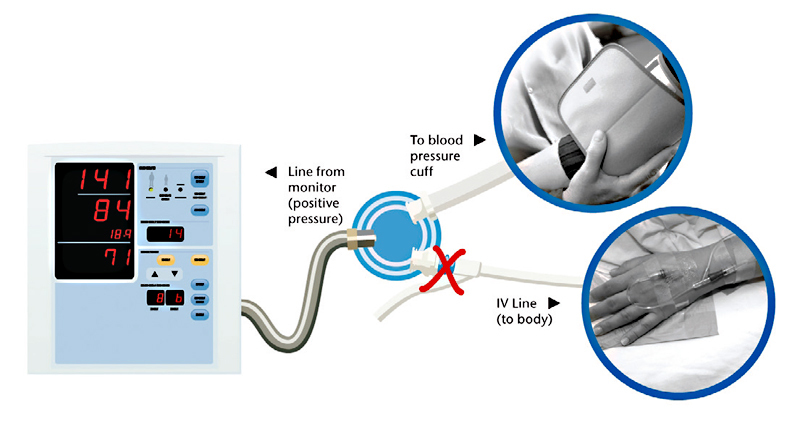By Jim Brown, Business Unit Manager, Colder Products Company, St. Paul, Minn.
Misconnected tubing in medical settings can cause serious problems. However, advances in connection technology can help eliminate these issues.

This new connector allows free tubing rotation to prevent accidental disconnection during use.
Accidental tubing misconnections involving luer fittings in medical environments are a patient safety issue. First introduced in 1896, the luer connector design developed into a common method of joining needles and syringes. Over time, it has extended into joining lengths of tubing that are a mainstay of modern medical applications. A variety of drug delivery systems, medical devices, and accessories use luer fittings. However, this common type of luer use can cause misconnections between incompatible devices – thereby causing potential patient injury or even death.
Patient safety groups are advocating the need for different connectors for different kinds of tubing. This would help eliminate the accidental link between connectors and incompatible devices and components. The consensus accepted by most device manufacturers and regulatory bodies is that when used around patients, luer fittings will be reserved for vascular access only. All other devices used near a patient or a hospital bed should have a different type of small bore connector; one that physically cannot connect with a luer fitting or incompatible devices. This scenario puts the burden on device manufacturers to determine what type of connector can replace luers for new product designs. The new technology will help reduce liability and prepare for impending new standards defining acceptable small bore connectors in medical applications.
Medical OEMs ask experts for new designs
Colder Products Company senior manager and project team leader Jim Hanson formed a cross-functional team to design an effective luer replacement that was easy to use, functionally superior to a luer, and simple for OEM device manufacturers to design into their products. The new small bore connector would prevent users from accidentally connecting their device with another system that could cause a serious health problem such as an embolism by delivering air into an IV line.
One of the biggest challenges for the team was time to market. To ensure an accelerated development process, the team employed best practice project management techniques including co-location of team members, increased early communication with supply chain partners, and phase-gate new product development processes.
Hanson organized multiple project teams, drawing on ideas from the best designers in the company to submit project proposals for close review. All designs were evaluated using a decision matrix specifically developed to rank the design aspects from a value producing perspective. The basic set of requirements was defined and each requirement was weighted in priority. “Cost was weighted high, but the certainty of preventing misconnection weighted highest in our decision matrix,” said Hanson.
Another criterion was size. “We didn’t want to create some-thing that would be too large; it had to seamlessly replace a luer,” Hanson added. Additional requirements included the cost of manufacturing, reliability, ease of use in the field, and how easily the connectors would adapt to different applications. At this stage, Colder sought input from OEM customers to confirm the final design details before proceeding.
Material selection
The scope of applications for the connector required biocomp-atibility, functional performance, and reliability. Only materials readily accepted in the medical arena were considered. They had to be ISO 10993 compliant, latex free, animal product free, and meet California Proposition 65 regulations addressing trace contaminants that are sometimes present in resins. The material had to withstand all forms of medical sterilization processes. In addition, the Colder team considered chemical compatibility of the connector material with different fluids and gases used in medical procedures.
A polypropylene (PP) material met all of the compatibility and regulatory requirements. But Hanson thought one material by itself would not sufficiently satisfy all functional requirements. So, the team chose a thermoplastic elastomer (TPE) to over-mold the connector’s seal making it more reliable than the plastic-on-plastic seal of a 6° tapered luer. This specially blended TPE also was used for the thumb pads to provide an intuitive signal that indicates to the user where to squeeze the part to disconnect it. Because TPEs can be easily blended with colorants, customers could choose a specific color to match the color scheme of their logo or product.

The new connector prevents misconnections with luer fittings.
Design and development process
Hanson’s team used several design techniques including rapid prototyping, finite element analysis (FEA), and mold flow analysis to minimize overall project duration. The group’s knowledge of injection molding, hose barb design, and fluid flow characteristics helped them to proceed quickly.
By prototyping early and often, the team was able to see how the final product would look and feel in the user’s hands. “CAD renderings are great, but nothing beats holding a part in your hand to get the true feel of the product,” Hanson stated. The team used stereolithography (SLA) and machined and molded prototypes to focus on design features and evaluate part ergonomics.
Working closely with injection molding process engineers, the team determined the best approach for molding the final design. Because two materials were needed to fulfill product requirements, the TPE would be over-molded onto the PP material. Even though two-shot molding is a complex process requiring specialized tooling and part measurement techniques, it was selected as the most cost-effective and reliable method of producing the final product.
FEA helped to assure mechanical loads would not exceed material capabilities. This process identified the maximum stress and strain levels within the part allowing the designers to optimize the unique latching mechanism prior to cutting tool steel. By using mold flow analysis, process engineers set gate and runner sizing to reduce molding flash. Thus, the team corrected part and tool design before molds were built, minimizing development cost and time.
“The team was able to save several weeks and thousands of dollars by using FEA and advanced mold flow analysis,” said Hanson. “Instead of building a tool and finding flaws that would result in significant tool rebuild, we were able to build it right the first time.” To further reduce tool development time, the team focused on “tool tweaking.” This iterative process can consume valuable development time when each step is completed serially. Hanson’s team machined prototype parts in parallel with the tool build, so only one tool tweak was needed to optimize the critical sealing surfaces on the final molded parts.
Design feedback
The best connector may meet all the product specifications, but if it isn’t user friendly, it’s not worth the effort. To enhance ergonomics, nurses, doctors and other medical industry experts tested the new connector for size and ease of use. “We wanted critical user feedback. We wanted the healthcare professional or home healthcare patient to know they made a secure connection,” said Hanson. “That could be an audible click, for example, or a tactile feel. Aside from being easy to connect and disconnect, it must be robust. We didn’t want something that could twist, pop off, or leak under side load. So it needed to be handled by the people who would be using it to see if it passed this final test.”
Final phase
The resulting connector is safer for non-vascular medical tubing applications than a luer. The connectors provide a secure latch design with a distinct, audible click to indicate a leak free connection has been made. To release the connection requires only a pressure squeeze. The new design allows the connected tubing halves to rotate relative to one another and maintain a secure connection that stays connected and leak free. Even more important, the new, patented connection cannot connect to a luer fitting. That phenomenon eliminates the potential for dangerous tubing misconnections.
Changing Standards
Standards are common for medical OEMs. ISO9001:2008 has been the basis for most companies’ quality systems for nearly 20 years. ISO13485 is quickly becoming just as common. Consider referencing ISO10993 for material biocompatibility information rather than Class VI testing.
In the mid 1990s, standards organizations around the world began to examine the issue of misconnections and the impact on patient safety related to the widespread use of luers. Regional standards and manufacturer-specific designs attempted to address this issue. But these created a proliferation of connectors and significant hurdles for manufacturers because the standards were not harmonized – and because luers continued to be used. It was clear a global, harmonized standard would be the first step toward creating a safer connection.
ISO TC210 came about after the Association for the Advancement of Medical Instrumentation (AAMI) established a joint working group in 2007 to develop a new standard for small bore connectors (defined as below 08.5-mm ID). This expanded ISO TC210’s scope from the standardization of requirements and guidance in the field of quality management and corresponding general aspects for medical devices, to specifically include small bore connectors.
This joint working group started the development of a consensual standard for small bore connectors defined as ISO 80369. Divided into seven sections, the first details the general requirements for small bore connectors and the following six detail the requirements for specific connectors in general applications:
• ISO 80369-1 General Requirements
• ISO 80369-2 Breathing Gas Systems
• ISO 80369-3 Enteral Feeding
• ISO 80369-4 Urological
• ISO 80369-5 Limb Cuffs
• ISO 80369-6 Neuraxial
• ISO 80369-7 Vascular/Luer fittings (formerly ISO 594)
Small bore connectors are not medical devices but their use can have an impact on the efficacy, quality, and safety of a medical device. This new standard will help define non-luer connectors and provide guidance for the use of safer connections in medical devices.
Discuss this on the Engineering Exchange:
Colder Products Company
www.colder.com
::Design World::

